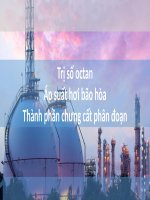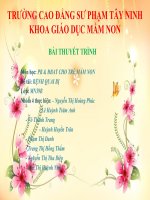English for Physic - Vật lí - Nguyễn Hoàng Huy - Thư viện Bài giảng điện tử
Bạn đang xem bản rút gọn của tài liệu. Xem và tải ngay bản đầy đủ của tài liệu tại đây (1.13 MB, 43 trang )
Course: Enghlish For Physics
Waves
Student:
Supervisor
TS. Phan Thị Kim Loan
Nguyễn Hoàng Huy
B1300564
waves
Introduction
1.
2.
3.
4.
5.
6.
Paragraph
Focus on the reading
Comprehension reading
Multiple choice
Translate into English
Exercises
1. Paragraph
Types of Waves
Mechanical waves need a material medium through which they can travel as they
transfer energy. Some example of mechanical waves are water waves, sound waves, and the
waves that travel along a spring or rope. The behavior of most mechanical waves can be
readily observed. The material through which the energy of a mechanical wave is transferred
from one particle to another is called a medium.
1. Paragraph
Electromagnetic waves are a large and important family of waves. They need no
medium through which to travel. Electromagnetic waves consisting of seven basic types: radio
waves, micro waves, infrared rays, visible light, ultraviolet, X rays and gamma rays.
Mechanical waves can be classified by the way in which they displace matter. There
are three general types of wave-transverse waves, longitudinal waves, and surface waves
1. Paragraph
A transverse wave cause the particles of a medium to vibrate perpendicularly to
the direction of the wave itself. A electromagnetic waves is an example of a transverse wave.
1. Paragraph
A longitudinal waves causes the particles of a medium to move parallel to the direction
of the waves. A sound wave is an example of a longitudinal wave.
1. Paragraph
Surface waves have characteristics of both
transverse and longitudinal waves. Surface waves
cause particle in the medium to move both
horizontally and vertically as the wave moves across
the surface. Water waves are example of surface
waves.
1. Paragraph
1. Paragraph
Wave Characteristics: Frequency, Wavelength, Amplitude and Wave speed
1. Paragraph
The amplitude, A, of a wave is the distance from the centre line (or the still position) to the top of a
crest or to the bottom of a trough. Amplitude is measured in metres (m). The greater the amplitude of a wave
then the more energy it is carrying.
The wavelength, λ, of a wave is the distance from any point on one wave to the same point on the next
wave along. (The symbol is a Greek letter, 'lambda'.) To avoid confusion, it is best to measure wavelength from
the top of a crest to the top of the next crest, or from the bottom of a trough to the bottom of the next trough.
Wavelength is also measured in metres (m).
1. Paragraph
The frequency, f, of a wave is the number of waves passing a point in a certain time. We normally use a
time of one second, so this gives frequency the unit hertz (Hz), since one hertz is equal to one wave per second.
Don't get confused with this quantity frequency. It is not a distance travelled by waves, nor is it a speed,
although it is linked to both of these quantities. For water waves and sound waves the unit hertz is usually good
enough but radio and TV waves have such a high frequency that the kilohertz (kHz) or even the megahertz
(MHz) are better units.
1 kHz = 1,000 Hz
1 MHz = 1,000,000 Hz
1. Paragraph
The speed (or sometimes you might see it called velocity) of a wave, v, is how far the
wave travels in a certain time. The speed of a wave depends upon the properties of the
medium through which the wave is traveling. Wave speed is measured in metres per second
(m/s).
The velocity of a wave can be found by calculating the product of the frequency and the
wavelength.
v= fv
1. Paragraph
Nodes, antinodes, and Standing Waves
Suppose two pulse have identical shapes but equal and opposite amplitude and move
toward each other in a medium. When they meet, there will be a point in the medium that is
completely undisturbed at all time. This point is called a node.
1. Paragraph
Consider two pulses with identical shapes and amplitudes traveling in opposite
direction in a medium. When the pulses meet, there will be a point in the medium that has a
displacement equal to the sum of the two amplitudes. This point of maximum displacement is
called an antinode. The antinoted is produced by constructive interference.
1. Paragraph
If one end of a string is connected to a vibrating source and the other end is attached to a fixed point, the
string will be set into motion causing periodic wave trains. Two wave trains are produced: one by the vibrating
source and the other by reflection of the original wave from the fixed end of the string. If there is no energy loss,
the two wave trains will have identical amplitudes and wavelength, but will be traveling in opposite directions.
The reflected wave returns to the source, constructive and destructive interference will occur producing
stationary antinodes and nodes. The string will appear to be vibrating in segments. This is called a standing
wave. Standing waves are example of resonance.
1. Paragraph
Diffraction and Interference of Waves
Diffraction is the bending of a wave around
obstacles placed in its path. Diffraction may
be observed in a ripple tank by placing a small
barrier in the path of parallel waves. The
waves bend around the edges of the barrier,
producing circular waves.
1. Paragraph
Figure 1. Diffraction of Waves
1. Paragraph
Interference is a phenomena that occurs
when two waves meet each other. There
are points where they reinforce as well
as points they cancel each other out
completely.
1. Paragraph
Figure 2. Interference of Waves
2. Working With Vocabulary
Fill in the blank with each of the following given words. Each word is used once
Determined
sound wave
frequencies
Wavelength
oscillation Ultrasound
vacuum
velocity
temperature
sound insulation
1. Sound sources is objects emit oscillating sound.The …..(1)….. frequency of the source as well as theoscillation
frequency of
the wave.
2. These oscillations have frequencies from 16Hz to 20000Hz called oscillator negative. Wave have frequency in that
region called….(2)…..
sound wave.
2. Working With Vocabulary
Determined
sound wave
frequencies
Wavelength
oscillation Ultrasound
vacuum
velocity
temperature
sound insulation
3. Mechanical waves with frequencies greater than 20000Hz is called….(3)….
ultrasound
4. Mechanical waves with …….(4)……. less than 16Hz called infrasound.
frequencies
5. Musical sound is …….(5)……. frequency sound,noise is sound with a frequency not determined.
determined
2. Working With Vocabulary
Determined
sound wave
frequencies
Wavelength
oscillation Ultrasound
vacuum
velocity
temperature
sound insulation
6. Sound waves transfer in solid medium, liquid and gas. Sound waves are not transmitted in ….(6)……
vacuum.
7. Sound velocity dependent elasticity,density environments the ambient ….(7)….
.
temperature .
2. Working With Vocabulary
Determined
sound wave
frequencies
Wavelength
oscillation Ultrasound
vacuum
velocity
temperature
sound insulation
8. In an environment, sound transmission with a determined speed. When sound transmission from environment
to environment other, the sound ….(8)…. change, the
frequency of the sound was not change.
……9)……. of the sound waves change the
velocity
9. Hardlywavelength
transmits sound through the porous material like cotton wool they are called ….(10)….
Insulation.









